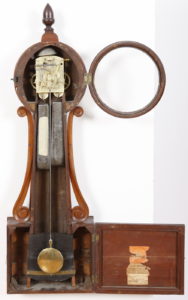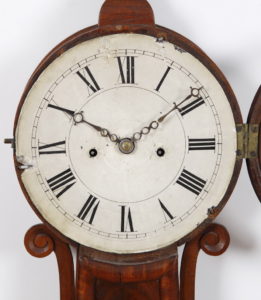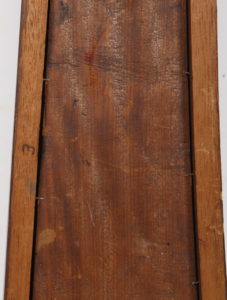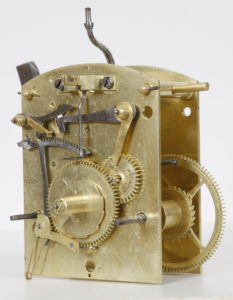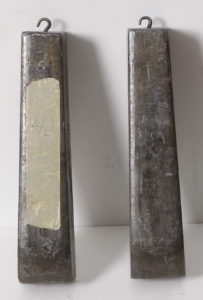Boston Striking Banjo Clock C. 1835
Banjo clocks with time and strike clockworks emerged in Boston during the 1820’s. The movements were modelled after tall clock movements and they were used in Massachusetts Shelf, Dwarf, Mirror, and Banjo Clocks. Basically the movement is a tall clock that has been resized to fit in a smaller case and run with a shorter pendulum, and shorter weight drop. Aaron Willard Jr., William Grant, John Sawin, and Ezekiel Jones are documented makers of these clocks. Some of the regional period details identifiable to this group include: arched top plate, recoil escapement, three pillars, 2 mounting holes that support “fillister head through bolts,” and interior bell. In this example there is a single rear center bolt in addition to the front mounting holes. Note the “coiled” retention spring on the bell hammer which is a design feature used by the Willard’s on their tall clocks. The cases are designed with a center divider in the weight well, sound holes in the backboard that flank the movement, and contour to accommodate the bell. The Mahogany case with turned wooden bezel, half round “Torus” molded frames, wooden tablets, flanked by reverse scroll carved side arms. The painted iron dial with Roman numerals measures 7 1/2 inches in diameter with a 6 1/2 inch time track and 7/8 inch numerals. Overall the clock measures 33 X 10 X 3 3/4 inches. The works have been professionally serviced and it runs and strikes fine. A pair of original cast lead weights power the time and strike train. The hands are steel with an interesting adaptation of the open loop design. Numerous repair notes and labels document the history of ownership. The case parts are die stamped “3” a common practice used by the Boston clockmakers.
Price $ 9500



